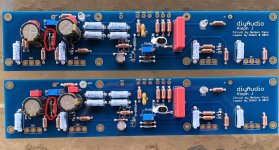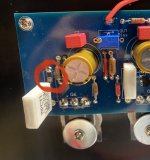What is the ground layout of volume buffer?It doesn’t make a difference if the volume buffer’s inputs are shorted. I get the same noise. The only near silent result is with the AlephJ’s inputs shorted. Everything else has noise.
So shorted inputs cancel the noise? Would having nothing in the inputs be a better indication of the Aleph J’s self noise?Shorting the input would feed the same noise to both -IN and +IN.
I did not have any noise with my Aleph J with a 10ohm ground lift resistor... (but I did have a noisy Aleph J without it)... have you posted the photos of your Aleph J? Maybe there's something wrong with the wiring...
I did the 10 Ohm mod that you suggested, and it made the amp quieter. Putting a shield between the power transformer and circuit boards made it quieter still. I haven’t done the gain reducing mod, but that is next on my list.
The volume buffer is in two chassis. I would need to draw it or take a photo to best show you. Removing the volume buffer from the chain doesn’t reduce noise though. DAC to AJ or DAC to volume buffer to AJ results in roughly the same noise. My speakers are 104 DB/W/M.What is the ground layout of volume buffer?
What is the ground layout of volume buffer?
Here are some photos of the underside of the power supply chassis and of the circuit chassis. When the AJ is fed directly by an iPhone’s headphone jack, the AJ is silent through the speakers. When the AJ has shorting plugs in its RCA jacks, it is silent, and when there is nothing plugged into the RCA jacks, it is also silent. I haven’t tried plugging the iPhone’s analogue headphone output into the volume buffer yet, but that’s my next experiment.
When the AJ is fed directly by an iPhone’s headphone jack, the AJ is silent through the speakers. When the AJ has shorting plugs in its RCA jacks, it is silent, and when there is nothing plugged into the RCA jacks, it is also silent.
The AJ is obviously not your problem 😃
Just wanted to drop in and say my Aleph J is finished. Have got it up and running for a week now and I’m very impressed by it. No noise, sounds extremely good, even compared to a pair of Quad II monoblocks.
The only thing that slightly worries me is that the negative rail doesn’t discharge as quickly as the positive rail on the PSU... Negative LEDs dim over a span of 2 minutes, while the positive ones go out immediatly.
Anyways. Next step is building a preamp for it.
Thanks to everyone involved,in this project. This thread and forum are an incredible source of knowledge.


The only thing that slightly worries me is that the negative rail doesn’t discharge as quickly as the positive rail on the PSU... Negative LEDs dim over a span of 2 minutes, while the positive ones go out immediatly.
Anyways. Next step is building a preamp for it.
Thanks to everyone involved,in this project. This thread and forum are an incredible source of knowledge.
Nice, but now it is time to give the Awesome Aleph J something more substantial to work with. With small speakers its like having a Muscular Friendly Velvet Giant (the Aleph J) batteling King Kong (the air in your listening room) swinging two small toothpicks (the speakers in the picture).Just wanted to drop in and say my Aleph J is finished. Have got it up and running for a week now and I’m very impressed by it. No noise, sounds extremely good, even compared to a pair of Quad II monoblocks.
The only thing that slightly worries me is that the negative rail doesn’t discharge as quickly as the positive rail on the PSU... Negative LEDs dim over a span of 2 minutes, while the positive ones go out immediatly.
Anyways. Next step is building a preamp for it.
Thanks to everyone involved,in this project. This thread and forum are an incredible source of knowledge.
View attachment 1120687
View attachment 1120688
Minimum one 15” per channel, for starters is my solid recommendation. 🎷🙂🎸
❤️🎅🏻❤️
Nice, but now it is time to give the Awesome Aleph J something more substantial to work with. With small speakers its like having a Muscular Friendly Velvet Giant (the Aleph J) batteling King Kong (the air in your listening room) swinging two small toothpicks (the speakers in the picture).
Minimum one 15” per channel, for starters is my solid recommendation. 🎷🙂🎸
❤️🎅🏻❤️
Thanks! I've got a few other speakers on the way. Recently redid a pair of Quad ESL57's (all electronics + new diafragms).
The amp is really good with those ESLs.
On the bench now are a pair of Gravesen's TQWT mk.2 and
In the warehouse there's a pair of La Scala clone's waiting for a new mid/high horn...
I searched the forum but couldn’t find any information for troubleshooting if there is issues getting Bias high enough.
I’m building a dual mono Aleph J and testing only one side first. The PSU gave me +-29V and with the board hooked up gave me +-26V. My issue is the bias will not get over .314V when I turn the trim pot all the way up. DC offset remained under 10mv.
I confirmed the pot is a 100k and it was set to 68k before being installed. The mosfets were purchased matched from RThatcher.
Any help is appreciated. I do not want to start the opposite side of the amp until I confirm the first side works.
Thanks.
I’m building a dual mono Aleph J and testing only one side first. The PSU gave me +-29V and with the board hooked up gave me +-26V. My issue is the bias will not get over .314V when I turn the trim pot all the way up. DC offset remained under 10mv.
I confirmed the pot is a 100k and it was set to 68k before being installed. The mosfets were purchased matched from RThatcher.
Any help is appreciated. I do not want to start the opposite side of the amp until I confirm the first side works.
Thanks.
I quickly found my issue. I tried to reset the source resistors so I could easily clip my multimeter to across for measuring. I had soldered the leg into the wrong pad.
After installing it correctly I was able to easily get the desired bias.
I am using Futaba MPC71 resistors and I had to bend the leads a specific way to get them to seat correctly on the board.
After installing it correctly I was able to easily get the desired bias.
I am using Futaba MPC71 resistors and I had to bend the leads a specific way to get them to seat correctly on the board.
I also played with 0.47ohm resistors... the Panasonic ones are very reliable, but they do not sound as lovely as wire-wound. I find Panasonic to be unnatural, and a bit bright. Very difficult to tame.
On the other hand, the wire wound ones like to go open-circuit...
On the other hand, the wire wound ones like to go open-circuit...
Hi EB,I also played with 0.47ohm resistors... the Panasonic ones are very reliable, but they do not sound as lovely as wire-wound. I find Panasonic to be unnatural, and a bit bright. Very difficult to tame.
On the other hand, the wire wound ones like to go open-circuit...
What wire-wound resistors are your pick of choice?
- Home
- Amplifiers
- Pass Labs
- Aleph J illustrated build guide

